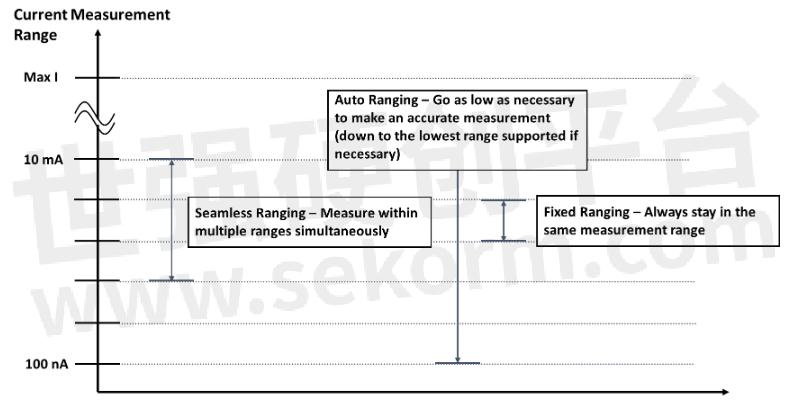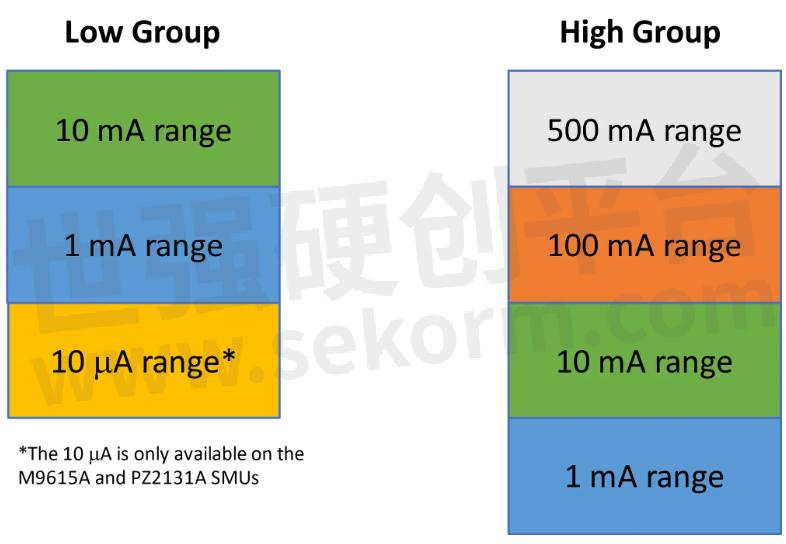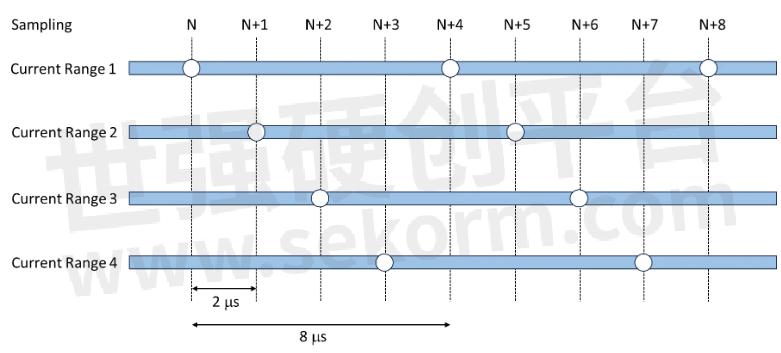What are the Differences between Auto, Seamless, and Fixed Measurement Ranging in An SMU?

Source/measure units (SMUs) often support multiple measurement range options, and selecting the correct one to use is important to optimize measurement resolution. However, before proceeding it is important to understand why SMUs have a range setting in the first place. The SMU circuitry has to switch in and out (using relays) different resistor values in order to handle the maximum expected current or voltage value under measurement. Obviously, it takes some time to switch these relays and move from one range to the next. For this reason, SMUs typically support different ranging modes to provide the user with options to help them achieve their measurement goals.

SMUs can support fixed ranging, auto-ranging, and seamless ranging (which is a patented capability unique to Keysight), although not all SMUs necessarily support all of these measurement ranging options. The following illustration shows how each of these choices impacts the range(s) used by the SMU for a current measurement:

Fixed measurement ranging yields the fastest test times, but it requires you to know something about the expected measurement value. In fixed ranging, you generally have enough resolution to measure quantities four to five decades below the measurement range used. However, if the quantity under measurement exceeds the value of the fixed measurement range, then you will get an error message. Auto-ranging is useful when you are measuring quantities where the expected value is unknown or constantly changing. In general, auto-ranging will start measuring in whatever range contains the user-specified limit (or compliance) value, and then it will work its way down into whatever range is necessary to make an accurate measurement. Since this process takes time, auto-ranging is almost always much slower than fixed-ranging. Some SMUs also support a “limited” auto-ranging feature, where the auto-ranging will not go below whatever measurement range the user specifies as the limit value (Note: Do not confuse this limit value with the voltage or current limit value). While this does not provide the same level of measurement resolution as full auto-ranging, it does speed up the measurement process considerably. Fixed ranging and auto ranging work best when performing either single point (spot) measurements, or when sweeping current or voltage and measuring the opposite value on a device under test (DUT).
If you want to measure a quantity over time that has rapid variations in its magnitude, then neither fixed ranging nor auto ranging is generally the best choice. An example of this is an IoT device that can draw hundreds of milliamps of current when active but might only draw a few microamps of current when inactive or in sleep mode. If you select the fixed range that contains the maximum expected value of current during active mode, then you will not be able to measure accurately the current during sleep mode. Auto-ranging does not work either since the SMU cannot uprange and downrange fast enough to keep up with the IoT device’s dynamic current changes. In this case, the best choice is seamless measurement ranging. Seamless measurement simultaneously measures in multiple ranges at once, and it selects the best measurement value from these ranges. The following graphs compare data taken on an IoT device using fixed ranging and seamless ranging.

Seamless measurement ranging only works when the SMU is in voltage force/current measurement mode. In addition, when seamless measurement ranging is in use some SMUs will operate in power supply mode regardless of the user setting (refer to operating manual for more information). In the case of Keysight’s PXI M96xxA SMUs and PZ2100A SMUs, the seamless ranging function uses one of two range groups (designated as “low” and “high”). The exact ranges included in each of these groups can vary depending on the particular specifications of the SMU under use, but the fundamental principles remain the same. The following illustration shows how the seamless ranging function divides up the measurement ranges for the M9615A and PZ2131A SMUs:

The SMU will select which group to use based on the compliance (or limit) value specified by the user. In this example, if the compliance value is higher than 10 mA then the SMU selects the high group. Otherwise, it selects the low group. Similar to the limited auto-ranging function described earlier, the seamless ranging function also allows you to specify a minimum range to use in the seamless ranging function. This can help prevent settling time issues when measuring very small currents. When performing a seamless ranging measurement, the SMU makes measurements sequentially across all ranges included in the group it is using as shown in the following figure:

In this example for the PZ2131A SMU, the minimum sampling rate for the measurements is two microseconds, so each seamless measurement takes eight microseconds. Making one seamless measurement effectively takes four times longer than it does to make one fixed-range measurement. Although the time required to make a seamless measurement is longer than for a fixed range measurement, the benefits of seamless measurement ranging are clear when you compare the measurement results. The following graph compares measurement performance versus time for the PZ2121A SMU module when applying a 0 V to 1 V sweep to the anode of a diode and measuring the current using fixed, seamless, and auto-ranging.

The measurement made using auto-ranging clearly gives the best measurement resolution, although it takes more time than the fixed and seamless measurements.
In conclusion, you can see that it is important to select the correct ranging mode for a measurement application. In general, fixed-ranging works best for simple measurements where you have some knowledge of the expected measurement value in advance. Auto-ranging often works best for situations where you are sweeping one parameter and measuring another parameter, and you need to get the greatest measurement resolution possible. Finally, seamless ranging is ideal for situations where you want to measure a parameter with wide changes in its value over time. Of course, there are exceptions to every rule. However, once you understand the principles explained in this blog you should be able to determine which measurement range mode is the best choice for your application.
- +1 Like
- Add to Favorites
Recommend
- Keysight Technologies Acquires Quantum Benchmar, Augmenting Keysight‘s Quantum Portfolio
- Keysight First to Gain OmniAir Qualified Test Equipment Status, Accelerating C-V2X Device Certification
- Keysight First to Gain GCF Approval of Cases for Validating 5G New Radio mmWave Devices in Standalone Mode
- Keysight Massively Parallel Board Test System Selected by LACROIX in Automotive Printed Circuit Board Manufacturing
- Keysight, TIM and JMA Wireless Join Forces to Showcase O-RAN Technology at Mobile World Congress 2021
- Keysight, Xilinx and Cisco Showcase Solutions that Support Smooth Migration from 4G LTE Networks to 5G Open RAN
- Keysight Unveils the First Media Access Control Security Test Solution for High Speed Ethernet
- What Is SMU Digitizer Mode and Why Is It Useful?
This document is provided by Sekorm Platform for VIP exclusive service. The copyright is owned by Sekorm. Without authorization, any medias, websites or individual are not allowed to reprint. When authorizing the reprint, the link of www.sekorm.com must be indicated.



















































































































































































































































































































































































































































































































































































































































































































































































































































































